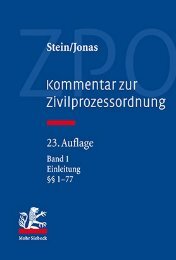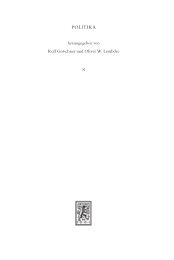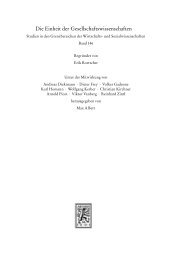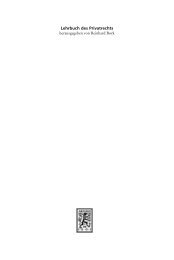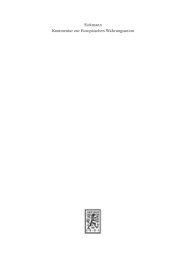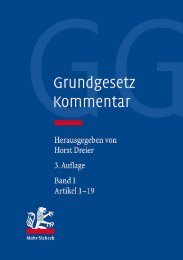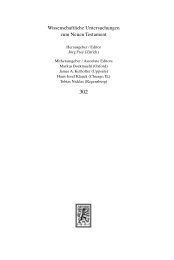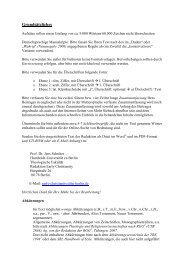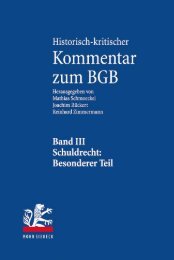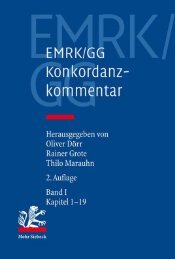Judaea-Palaestina, Babylon and Rome: Jews in Antiquity
Judaea-Palaestina, Babylon and Rome: Jews in Antiquity
Judaea-Palaestina, Babylon and Rome: Jews in Antiquity
You also want an ePaper? Increase the reach of your titles
YUMPU automatically turns print PDFs into web optimized ePapers that Google loves.
Texts <strong>and</strong> Studies <strong>in</strong> Ancient Judaism<br />
Texte und Studien zum Antiken Judentum<br />
Edited by<br />
Peter Schäfer (Pr<strong>in</strong>ceton, NJ)<br />
Annette Y. Reed (Philadelphia, PA)<br />
Seth Schwartz (New York, NY)<br />
Azzan Yad<strong>in</strong> (New Brunswick, NJ)<br />
147
<strong>Judaea</strong>-<strong>Palaest<strong>in</strong>a</strong>,<br />
<strong>Babylon</strong> <strong>and</strong> <strong>Rome</strong>:<br />
<strong>Jews</strong> <strong>in</strong> <strong>Antiquity</strong><br />
edited by<br />
Benjam<strong>in</strong> Isaac <strong>and</strong> Yuval Shahar<br />
Mohr Siebeck
Benjam<strong>in</strong> Isaac, born 1945; immigrated to Israel <strong>in</strong> 1972; studied <strong>in</strong> Amsterdam, the Netherl<strong>and</strong>s;<br />
currently Fred <strong>and</strong> Helen Less<strong>in</strong>g Professor of Ancient History, Tel Aviv University;<br />
member of the Israel Academy of Sciences <strong>and</strong> Humanities; Israel Prize Laureate.<br />
Yuval Shahar, born 1953; studied Jewish History <strong>and</strong> Jewish Philosophy at Tel Aviv University;<br />
currently Senior Lecturer <strong>in</strong> the Department of Jewish History <strong>and</strong> Head of The Multidiscipl<strong>in</strong>ary<br />
Program <strong>in</strong> the Humanities, Tel Aviv University.<br />
ISBN 978-3-16-151697-9<br />
ISSN 0721-8753 (Texts <strong>and</strong> Studies <strong>in</strong> Ancient Judaism)<br />
Die Deutsche Nationalbibliothek lists this publication <strong>in</strong> the Deutsche Nationalbibliographie;<br />
detailed bibliographic data is available on the Internet at http://dnb.d-nb.de.<br />
© 2012 by Mohr Siebeck, Tüb<strong>in</strong>gen, Germany.<br />
This book may not be reproduced, <strong>in</strong> whole or <strong>in</strong> part, <strong>in</strong> any form (beyond that permitted by<br />
copyright law) without the publisher’s written permission. This applies particularly to reproductions,<br />
translations, microfilms <strong>and</strong> storage <strong>and</strong> process<strong>in</strong>g <strong>in</strong> electronic systems.<br />
The book was typeset by Mart<strong>in</strong> Fischer <strong>in</strong> Tüb<strong>in</strong>gen us<strong>in</strong>g Times typeface, pr<strong>in</strong>ted by Gulde-<br />
Druck <strong>in</strong> Tüb<strong>in</strong>gen on non-ag<strong>in</strong>g paper <strong>and</strong> bound by Buchb<strong>in</strong>derei Sp<strong>in</strong>ner <strong>in</strong> Ottersweier.<br />
Pr<strong>in</strong>ted <strong>in</strong> Germany.
Preface<br />
In December of 2009 Tel Aviv University hosted an <strong>in</strong>ternational conference <strong>in</strong><br />
honour of Aharon Oppenheimer, Sir Isaac Wolfson Professor of Jewish History,<br />
on the occasion of his retirement. The present volume publishes most of the<br />
papers read dur<strong>in</strong>g the conference <strong>and</strong> it is dedicated to him by his friends <strong>and</strong><br />
colleagues <strong>in</strong> recognition of many years of a broad range of activities: teach<strong>in</strong>g,<br />
research, <strong>and</strong> adm<strong>in</strong>istration, all of them carried out with wisdom, unselfishly<br />
<strong>and</strong> honestly.<br />
The editors wish to thank those who made the event possible, those who<br />
participated <strong>in</strong> it <strong>and</strong> those who worked hard to make it a success. First, we<br />
gratefully acknowledge the generous f<strong>in</strong>ancial contributions made by various<br />
persons <strong>and</strong> <strong>in</strong>stitutions: the President of Tel Aviv University, the Rector, Vice-<br />
President for Research <strong>and</strong> Development, the Dean of the Faculty of Humanities,<br />
the School of Jewish Studies, the Goldste<strong>in</strong>-Goren Center for Diaspora Research<br />
<strong>and</strong> its Director, Dr Simha Gold<strong>in</strong>, the Fred Less<strong>in</strong>g Institute for European History<br />
<strong>and</strong> Civilization <strong>and</strong> Ms Joan Less<strong>in</strong>g, <strong>and</strong> the Mortimer <strong>and</strong> Raymond<br />
Sackler Institute of Advanced Studies.<br />
Special mention should be made of <strong>in</strong>valuable assistance rendered by Sara<br />
Appel <strong>and</strong> Ora Azta of the Goldste<strong>in</strong>-Goren Center who took care of all practical<br />
arrangements <strong>in</strong> prepar<strong>in</strong>g the event. Their labours were <strong>in</strong>strumental <strong>in</strong> achiev<strong>in</strong>g<br />
a conference virtually without practical flaws.<br />
Susan We<strong>in</strong>garten helped improv<strong>in</strong>g the style of part of the contributions. We<br />
are very grateful for her generous assistance. F<strong>in</strong>ally, cordial thanks are due to<br />
Nili Oppenheimer for the preparation of the list of Aharon Oppenheimer’s publications<br />
at the end of this book.<br />
Benjam<strong>in</strong> Isaac & Yuval Shahar Tel Aviv University, September 2011
Table of Contents<br />
Benjam<strong>in</strong> Isaac <strong>and</strong> Yuval Shahar<br />
Introduction . . . . . . . . . . . . . . . . . . . . . . . . . . . . . . . . . . . . . . . . . . . . . . . . . 1<br />
The Image of <strong>Jews</strong> among Non-<strong>Jews</strong><br />
Albert I. Baumgarten<br />
The “Outreach” Campaign of the Ancient Pharisees:<br />
There is no such th<strong>in</strong>g as a Free Lunch . . . . . . . . . . . . . . . . . . . . . . . . . . . . 11<br />
Shaye J. D. Cohen<br />
Danc<strong>in</strong>g, Clapp<strong>in</strong>g, Meditat<strong>in</strong>g: Jewish <strong>and</strong> Christian Observance<br />
of the Sabbath <strong>in</strong> Pseudo-Ignatius . . . . . . . . . . . . . . . . . . . . . . . . . . . . . . . 29<br />
The Image of Non-<strong>Jews</strong> among <strong>Jews</strong><br />
Joshua Schwartz<br />
How Jewish to be Jewish? Self-Identity <strong>and</strong> Jewish Christians<br />
<strong>in</strong> First Century CE Palest<strong>in</strong>e . . . . . . . . . . . . . . . . . . . . . . . . . . . . . . . . . . . 55<br />
Günter Stemberger<br />
Birkat ha-m<strong>in</strong>im <strong>and</strong> the separation of Christians <strong>and</strong> <strong>Jews</strong> . . . . . . . . . . . . 75<br />
Vered Noam<br />
Another look at the rabb<strong>in</strong>ic conception of gentiles<br />
from the perspective of impurity laws . . . . . . . . . . . . . . . . . . . . . . . . . . . . 89<br />
Richard Kalm<strong>in</strong><br />
The Evil Eye <strong>in</strong> Rabb<strong>in</strong>ic Literature of Late <strong>Antiquity</strong> . . . . . . . . . . . . . . . . 111<br />
Peter Schäfer<br />
Jesus’ Orig<strong>in</strong>, Birth, <strong>and</strong> Childhood accord<strong>in</strong>g to the Toledot Yeshu<br />
<strong>and</strong> the Talmud . . . . . . . . . . . . . . . . . . . . . . . . . . . . . . . . . . . . . . . . . . . . . . 139
VIII Table of Contents<br />
Social History<br />
Tessa Rajak<br />
Reflections on Jewish Resistance <strong>and</strong> the Discourse of Martyrdom<br />
<strong>in</strong> Josephus . . . . . . . . . . . . . . . . . . . . . . . . . . . . . . . . . . . . . . . . . . . . . . . . . 165<br />
Mart<strong>in</strong> Goodman<br />
Titus, Berenice <strong>and</strong> Agrippa: The Last Days of the Temple <strong>in</strong> Jerusalem 181<br />
Yuval Shahar<br />
Why a quarter? The Siqariqon rul<strong>in</strong>g <strong>and</strong> Roman Law . . . . . . . . . . . . . . . 191<br />
Susan We<strong>in</strong>garten<br />
How do you say haroset <strong>in</strong> Greek? . . . . . . . . . . . . . . . . . . . . . . . . . . . . . . . 205<br />
Jonathan J. Price<br />
The Necropolis at Jaffa <strong>and</strong> its Relation to Beth She‘arim . . . . . . . . . . . . . 215<br />
Youval Rotman<br />
Captives <strong>and</strong> Redeem<strong>in</strong>g Captives: the Law <strong>and</strong> the Community . . . . . . . 227<br />
Werner Eck<br />
The Jewish Community <strong>in</strong> Cologne from Roman Times<br />
to the Early Middle Age . . . . . . . . . . . . . . . . . . . . . . . . . . . . . . . . . . . . . . . 249<br />
Issues <strong>in</strong> Modern Scholarship<br />
David Goodblatt<br />
The <strong>Jews</strong> <strong>in</strong> the Parthian Empire: What We Don’t Know . . . . . . . . . . . . . . 263<br />
Yoram Tsafrir<br />
The F<strong>in</strong>ds <strong>in</strong> Cave 2001–2002 <strong>and</strong> Burial at Masada . . . . . . . . . . . . . . . . . 279<br />
Isaiah Gafni<br />
Will the ‘Real’ Rabbis Please St<strong>and</strong> Up: On the Repackag<strong>in</strong>g of the<br />
Rabb<strong>in</strong>ic Model <strong>in</strong> Modern Times . . . . . . . . . . . . . . . . . . . . . . . . . . . . . . . 295
Table of Contents<br />
Publications of Aharon Oppenheimer . . . . . . . . . . . . . . . . . . . . . . . . . . . . . 309<br />
Index . . . . . . . . . . . . . . . . . . . . . . . . . . . . . . . . . . . . . . . . . . . . . . . . . . . . . . 317<br />
Ancient writers . . . . . . . . . . . . . . . . . . . . . . . . . . . . . . . . . . . . . . . . . . . . 317<br />
Modern scholars . . . . . . . . . . . . . . . . . . . . . . . . . . . . . . . . . . . . . . . . . . . 318<br />
General Index . . . . . . . . . . . . . . . . . . . . . . . . . . . . . . . . . . . . . . . . . . . . . 320<br />
IX
Introduction<br />
Benjam<strong>in</strong> Isaac <strong>and</strong> Yuval Shahar<br />
This volume conta<strong>in</strong>s most of the papers read at a conference held <strong>in</strong> honour<br />
of Aharon Oppenheimer <strong>in</strong> December of 2009. For decades Oppenheimer has<br />
studied <strong>and</strong> taught Jewish history “<strong>in</strong> the period of the Mishnah <strong>and</strong> the Talmud,”<br />
as it is called at Tel Aviv University. He has done so with much energy,<br />
great learn<strong>in</strong>g, <strong>in</strong>tellectual honesty <strong>and</strong> a f<strong>in</strong>e sense of humour. His published<br />
achievements are listed at the end of this volume. His contribution as a teacher,<br />
a colleague, <strong>and</strong> editor of journals <strong>and</strong> academic publications is less easily measured,<br />
although obvious to all who know him. When organiz<strong>in</strong>g the conference<br />
it was our aim to <strong>in</strong>vite a number of friends <strong>and</strong> colleagues who represent the<br />
wide range of his publications <strong>in</strong> the field of Jewish history <strong>in</strong> antiquity. Pride of<br />
place among these goes to the <strong>Jews</strong> <strong>in</strong> <strong>Judaea</strong> <strong>in</strong> antiquity, subject of the articles<br />
by Albert Baumgarten, Joshua Schwartz, Yoram Tsafrir, Günter Stemberger,<br />
<strong>and</strong> Vered Noam. To some extent Peter Schäfer’s paper also belongs <strong>in</strong> this<br />
category. Then there are specific subjects concern<strong>in</strong>g the <strong>Jews</strong> under Roman<br />
rule, discussed by Mart<strong>in</strong> Goodman, Tessa Rajak <strong>and</strong> Yuval Shahar, with the<br />
addition of a paper <strong>in</strong> the sphere of cul<strong>in</strong>ary culture by Susan We<strong>in</strong>garten, one<br />
of the results of a project headed by Aharon Oppenheimer <strong>and</strong> Werner Eck.<br />
From there we move to the diaspora. Aharon Oppenheimer is the author of a<br />
major work on Jewish <strong>Babylon</strong>ia, a subject revisited here by David Goodblatt.<br />
The relationship <strong>and</strong> cultural differences between Palest<strong>in</strong>ian <strong>and</strong> <strong>Babylon</strong>ian<br />
<strong>Jews</strong> is the subject of Richard Kalm<strong>in</strong>’s contribution. Aharon Oppenheimer has<br />
published as well on Jewish burial <strong>in</strong> the diaspora <strong>and</strong> <strong>in</strong> Israel <strong>and</strong> on urban<br />
development. Hence we <strong>in</strong>clude a paper by Jonathan Price on Jewish epitaphs<br />
<strong>in</strong> Jaffa <strong>and</strong> Beth Shearim. Shaye Cohen focuses on a Christian text from<br />
fourth-century Syria about the Jewish Shabbat. Youval Rotman exam<strong>in</strong>ed the<br />
attitude <strong>and</strong> practice of both <strong>Jews</strong> <strong>and</strong> Christians toward the issue of redeem<strong>in</strong>g<br />
captives. Central <strong>in</strong> the work of any historian of the Jewish people <strong>in</strong> this period<br />
is an assessment of the role of the rabbis, or rather, the sages, as some prefer to<br />
call them. This is the subject of Isaiah Gafni’s paper. Aharon Oppenheimer’s<br />
personal pre-history goes back to Germany, where he has spent several years<br />
teach<strong>in</strong>g <strong>and</strong> study<strong>in</strong>g. It is only fitt<strong>in</strong>g that Werner Eck’s contribution should<br />
consider the presence of <strong>Jews</strong> <strong>in</strong> Cologne <strong>in</strong> antiquity, a city where Aharon<br />
himself has found extended hospitality.
2<br />
Benjam<strong>in</strong> Isaac <strong>and</strong> Yuval Shahar<br />
Albert Baumgarten’s paper takes up the theme of missionary activity, focus<strong>in</strong>g<br />
on the Pharisees <strong>in</strong> the pre-70 years aga<strong>in</strong>st the social reality of contemporary society.<br />
In the early to mid-1990s, a series of studies argued aga<strong>in</strong>st the then widely<br />
prevalent view that the ancient Pharisees were engaged <strong>in</strong> a major campaign to<br />
convert as many people as possible to Judaism <strong>in</strong> general <strong>and</strong> to the Pharisaic<br />
way of life <strong>in</strong> particular. Those who reacted aga<strong>in</strong>st this view argued that the<br />
missionary activity of <strong>Jews</strong>/ Pharisees was directed <strong>in</strong>ternally, towards those<br />
<strong>Jews</strong> whose attachment to the ancestral traditions seemed <strong>in</strong> need of re<strong>in</strong>forcement,<br />
not towards outsiders. Baumgarten’s declared aim is to free the study of<br />
the ancient Pharisees from the distortions of theological evaluation. The Pharisees<br />
still are frequently the subject of fierce disagreement between Christian<br />
<strong>and</strong> Jewish scholars, <strong>and</strong> among <strong>Jews</strong> as well. The paper aims to <strong>in</strong>ject clarity<br />
by analyz<strong>in</strong>g three passages <strong>in</strong> the gospel of Luke: 14:1–9; 7:36–9; 11:37–41.<br />
It is here argued that these <strong>in</strong>tended to show fundamental flaws <strong>in</strong> the Pharisaic<br />
claim of moderation, flexibility, <strong>and</strong> outreach to the larger world. This part of<br />
the discussion therefore deals with early Christian attitudes toward <strong>Jews</strong>, one<br />
of two <strong>in</strong> the volume to do so. It goes on with an attempt to sketch the realities<br />
beh<strong>in</strong>d this criticism.<br />
In this paper thus one of the themes of the book is represented: <strong>Jews</strong> <strong>and</strong> others.<br />
It is an attempt to describe how a significant movement <strong>in</strong> the first century<br />
attempted to make its mark <strong>in</strong>ternally rather than extend <strong>in</strong>fluence among non-<br />
<strong>Jews</strong>. This, aga<strong>in</strong>, is an important chapter <strong>in</strong> the evolv<strong>in</strong>g image of first century<br />
Judaism as projected <strong>in</strong> the early Christian sources <strong>and</strong> modern scholarship.<br />
Shaye Cohen’s paper is the second that focuses on Christian attitudes toward<br />
<strong>Jews</strong>. He uses patristic literature, a passage of pseudo-Ignatius (Syria, second<br />
half of the fourth century), as evidence for the Jewish observance of the Sabbath,<br />
one of the traditional po<strong>in</strong>ts of friction between non-<strong>Jews</strong> <strong>and</strong> <strong>Jews</strong>. As described<br />
<strong>in</strong> the text, <strong>Jews</strong> observe the Sabbath rejoic<strong>in</strong>g <strong>in</strong> idleness, <strong>in</strong> the relaxation of<br />
the body, eat<strong>in</strong>g day-old foods, dr<strong>in</strong>k<strong>in</strong>g lukewarm dr<strong>in</strong>ks, walk<strong>in</strong>g measured<br />
distances, <strong>and</strong> danc<strong>in</strong>g <strong>and</strong> clapp<strong>in</strong>g. For Christians, the source asserts, the<br />
spiritual observance of the Sabbath consisted of a) rejoic<strong>in</strong>g <strong>in</strong> meditation on<br />
laws <strong>and</strong> b) marvell<strong>in</strong>g at the creative work of God. This demonstrates a contrast<br />
between carnal <strong>Jews</strong> <strong>and</strong> spiritual Christians, a topos <strong>in</strong> Christian literature<br />
beg<strong>in</strong>n<strong>in</strong>g with Paul. Cohen concludes that the assertions regard<strong>in</strong>g the actual<br />
behaviour of <strong>Jews</strong> on the Sabbath presumably reflect reality. Food <strong>and</strong> dr<strong>in</strong>k<strong>in</strong>g<br />
are important to <strong>Jews</strong> celebrat<strong>in</strong>g the Sabbath. However, danc<strong>in</strong>g <strong>and</strong> clapp<strong>in</strong>g is<br />
less obvious as a custom, although it is attested <strong>in</strong> a few other sources: August<strong>in</strong>e<br />
<strong>and</strong> the Bavli. Christian sources take this a step further: good Christians actually<br />
observe the Sabbath every day, while the Jewish Sabbath is one day out of seven.<br />
With Joshua Schwartz’s paper we pass on to the general theme of the attitude<br />
of <strong>Jews</strong> toward non-<strong>Jews</strong> <strong>in</strong> antiquity, for it considers the highly sensitive <strong>and</strong><br />
controversial topic of Jewish identity <strong>in</strong> the first century as well as Jewish at-
Introduction 3<br />
titudes toward the early Christians. What was the character of Judaism? It was<br />
a religion, says Schwartz, namely a religion of law <strong>and</strong> of halakhah, stress<strong>in</strong>g<br />
praxis <strong>and</strong> works. There was not as much diversity as sometimes claimed, but<br />
the early Christians were not necessarily excluded from the Jewish community.<br />
Like that of Schwartz, Günter Stemberger’s contribution discusses the attitudes<br />
of <strong>Jews</strong> toward non-<strong>Jews</strong>. He renews the discussion of the birkat ham<strong>in</strong>im.<br />
The <strong>in</strong>terpretation of this text is essential for an underst<strong>and</strong><strong>in</strong>g of Jewish<br />
attitudes toward non-<strong>Jews</strong> <strong>in</strong> the late first <strong>and</strong> early second centuries. A common<br />
conclusion is that the text was formulated <strong>in</strong> the late first century by Rabban<br />
Gamaliel <strong>in</strong> Yavneh with the explicit purpose of exclud<strong>in</strong>g Christians or Jewish-<br />
Christians from participation <strong>in</strong> synagogue services. It would thus have been a<br />
formal act separat<strong>in</strong>g Christians from <strong>Jews</strong>. Two questions are elementary: the<br />
dat<strong>in</strong>g <strong>and</strong> the precise mean<strong>in</strong>g of the term ‘m<strong>in</strong>im.’ Stemberger accepts the<br />
usual date, but concludes that it is not quite clear how widespread was the application<br />
of restrictions mentioned <strong>in</strong> the text, nor is it obvious that ‘m<strong>in</strong>im’ <strong>in</strong><br />
this period always refers to Christians. Rabban Gamaliel’s special status may not<br />
have been so obvious at the time <strong>and</strong> the <strong>in</strong>stitution of the synagogue was not yet<br />
universal. The birkat ha-m<strong>in</strong>im would then not be evidence of a radical, formal<br />
break with Christians <strong>in</strong> this period <strong>and</strong> the text will not have played more than<br />
a m<strong>in</strong>imal role <strong>in</strong> the separation of Christians <strong>and</strong> <strong>Jews</strong>.<br />
Vered Noam offers a fasc<strong>in</strong>at<strong>in</strong>g analysis of the question of gentile impurity <strong>in</strong><br />
Talmudic sources with particular attention to issues of corpse impurity. She has<br />
used this as evidence for the self-image of <strong>Jews</strong> <strong>and</strong> their views of non-<strong>Jews</strong> with<br />
particular focus on the impurity of non-<strong>Jews</strong>. The assumption is that the impurity<br />
ascribed to non-<strong>Jews</strong> may be used as a source of <strong>in</strong>formation on the general<br />
rabb<strong>in</strong>ic portrait of the non-<strong>Jews</strong> <strong>and</strong> <strong>Jews</strong>. The question asked is whether non-<br />
<strong>Jews</strong> are <strong>in</strong>tr<strong>in</strong>sically impure, or only when they have been polluted by corpses;<br />
furthermore, can they be purified or not? The Tannaitic answer to this question is<br />
that only a captive who became a proselyte <strong>in</strong> the full sense of the law as def<strong>in</strong>ed<br />
by the rabbis could contract corpse impurity <strong>and</strong> require purification like an Israelite.<br />
A gentile, on the other h<strong>and</strong>, neither contracts nor conveys corpse impurity.<br />
Like the domestic animal <strong>and</strong> the eight-month child he fails to meet the def<strong>in</strong>ition<br />
of a human be<strong>in</strong>g, <strong>and</strong> is perceived as fundamentally different from a Jew. Accord<strong>in</strong>gly<br />
he is treated <strong>in</strong> categories of nature, <strong>in</strong> contradist<strong>in</strong>ction to culture <strong>and</strong><br />
jurisprudence. By contrast, Israel was regarded as an advanced society, governed<br />
by the law, i.e. Torah. This represents, to a certa<strong>in</strong> extent, a paradox: members of<br />
the community are liable to impurity, outsiders are not. An extreme consequence<br />
of this was formulated by R. Shimon ben Yohai: even graves of non-<strong>Jews</strong> do not<br />
cause impurity, for gentiles are not <strong>in</strong>cluded with<strong>in</strong> the term םדא, human be<strong>in</strong>g,<br />
<strong>in</strong> the verse להאב תומי יכ םדא, “When a person dies <strong>in</strong> a tent” (Numbers 19:14).<br />
Richard Kalm<strong>in</strong> deals with a topic that most scholars would look at askance:<br />
the evil eye <strong>in</strong> Talmudic sources. He shows it may serve as a valuable source
4<br />
Benjam<strong>in</strong> Isaac <strong>and</strong> Yuval Shahar<br />
of <strong>in</strong>formation about the Jewish self-image as presented <strong>in</strong> Palest<strong>in</strong>ian <strong>and</strong><br />
<strong>Babylon</strong>ian sources, the views the <strong>Jews</strong> held of each other <strong>and</strong> of their non-<br />
Jewish environment. Remarkable is the pronounced difference between these<br />
two groups of sources. The Palest<strong>in</strong>ian ones regard the evil eye as a weapon<br />
belong<strong>in</strong>g to others, not to <strong>Jews</strong>. The earlier, Tannaitic sources recognize only<br />
its non-magic form. Post-tannaitic sources also accept the existence of the<br />
magic version, <strong>and</strong> f<strong>in</strong>d that the Roman Empire is to blame for its existence.<br />
<strong>Babylon</strong>ian sources have an entirely different view: the evil eye can be Jewish<br />
or not. It is not restricted to others, to non-<strong>Jews</strong> <strong>and</strong> it is used by <strong>Jews</strong> among<br />
each other, even by lesser Rabbis. The Bavli recognizes means to neutralize it<br />
as a weapon. Another dist<strong>in</strong>ction: the Yerushalmi attempts to br<strong>and</strong> the evil eye<br />
as a <strong>Babylon</strong>ian problem, not a Palest<strong>in</strong>ian one. The Bavli does not attempt to<br />
do the reverse. These conclusions then say as much about contemporary views<br />
of the supernatural as about attitudes toward others <strong>and</strong> themselves amongst<br />
the two communities.<br />
With Peter Schäfer’s article we focus on later Jewish views of Christianity, notably<br />
the reports on Jesus’ orig<strong>in</strong>s as reflected <strong>in</strong> Jewish sources, with particular<br />
emphasis on the Toledot Yeshu, a group of mediaeval Jewish texts on Jesus (Yeshu).<br />
The impression it gives of the image of Jesus among <strong>Jews</strong> <strong>in</strong> this period is<br />
noteworthy. The central issue is not Jesus as blasphemer <strong>and</strong> false messiah who<br />
pretended to be the son of god. Miriam, his mother,is depicted without hostility,<br />
the victim of rape <strong>and</strong> not to blame for what happened. There was no virg<strong>in</strong> birth,<br />
of course, <strong>and</strong> Jesus rema<strong>in</strong>s a bastard, but his mother is <strong>in</strong>nocent. Jesus himself<br />
is depicted rather as a bad Torah student, guilty of arrogant behaviour toward his<br />
teachers. This is a remarkabe Jewish response to Christianity, although, admittedly,<br />
the source belongs to a period considerably later than the one which is the<br />
subject of this volume.<br />
The subject of Mart<strong>in</strong> Goodman’s study is the small number of elite <strong>Jews</strong> who<br />
witnessed the destruction of the sanctuary not as defenders of Jerusalem, nor<br />
from a safe distance <strong>in</strong> the diaspora, but from with<strong>in</strong> (or close to) the headquarters<br />
of the Roman general. Of these <strong>Jews</strong> one, the historian Josephus, played a<br />
role <strong>in</strong> Titus’ dynastic ambitions as the prophet alleged to have predicted already<br />
<strong>in</strong> 67 CE that Vespasian would become emperor. Three others – Agrippa II, his<br />
sister Berenice, <strong>and</strong> Tiberius Julius Alex<strong>and</strong>er were close associates of Titus.<br />
While Tiberius Alex<strong>and</strong>er had <strong>in</strong> fact ab<strong>and</strong>oned Judaism, Josephus never distanced<br />
himself from the Jewish people, whatever his role dur<strong>in</strong>g the war. The<br />
paper discusses Agrippa <strong>and</strong> Berenice <strong>in</strong> particular: they are not mentioned <strong>in</strong><br />
Talmudic sources, but that is not significant <strong>in</strong> itself, for, important though they<br />
were, they were irrelevant to the central topics of these sources. Their father,<br />
Agrippa I, is well known for his devotion to the Temple <strong>and</strong> Jewish religion.<br />
He <strong>and</strong> his children were part of the eastern aristocracy who, at the same time,<br />
played a role <strong>in</strong> Roman society, social <strong>and</strong> political. Goodman’s paper shows
Introduction 5<br />
how they comb<strong>in</strong>ed their role <strong>in</strong> Roman society with an active commitment to<br />
their religion, the Temple cult <strong>and</strong> <strong>Judaea</strong>n affairs. As such they form a rare <strong>and</strong><br />
vivid example of the manner <strong>in</strong> which eastern aristocracy ma<strong>in</strong>ta<strong>in</strong>ed its local<br />
ties <strong>and</strong> identity <strong>and</strong>, at the same time, was <strong>in</strong>tegrated <strong>in</strong> the imperial elite.<br />
Tessa Rajak contributes a thoughtful reconsideration of a highly sensitive <strong>and</strong><br />
complex subject: Jewish resistance <strong>and</strong> martyrdom under Roman rule. While the<br />
title might suggest that the discussion is limited to Josephus, the po<strong>in</strong>t is rather<br />
that a proper <strong>in</strong>terpretation of the evidence from Josephus has broader implications<br />
for our views of martyrdom as a significant factor <strong>in</strong> the Jewish resistance<br />
aga<strong>in</strong>st <strong>Rome</strong> <strong>in</strong> the first <strong>and</strong> second centuries. To some extent this has implications<br />
also for the <strong>in</strong>teraction between <strong>Jews</strong> <strong>and</strong> Christians <strong>and</strong> thus fits the topics<br />
of the papers concerned with these relations. At the same time it is a salutary<br />
rem<strong>in</strong>der that the <strong>in</strong>terpretation of Josephus’ work is never simple.<br />
Yuval Shahar deals with the siqariqon rul<strong>in</strong>g (Mishnah Gitt<strong>in</strong> v, 6) <strong>and</strong> the<br />
conditions which allow a Jew <strong>in</strong> Eretz Israel to buy a field that was confiscated<br />
earlier from another Jew because of anti-Roman activities. The paper deals with<br />
a specific question that has not been asked before: why a quarter must be given<br />
to the orig<strong>in</strong>al owner. The ‘quarter’ plays no role <strong>in</strong> any connection with the<br />
laws concern<strong>in</strong>g sale, <strong>in</strong>heritance <strong>and</strong> the like, neither <strong>in</strong> biblical Law nor <strong>in</strong> the<br />
post-biblical halakhah that developed until the redaction of the Mishnah. On the<br />
other h<strong>and</strong> three historical phases <strong>in</strong> the course of the development of the Roman<br />
law of succession show the quarter as an important element. The last stage, <strong>in</strong><br />
the time of Anton<strong>in</strong>us Pius, is connected with the Law of Trusts (Fideicommissa)<br />
<strong>and</strong> extended the ‘quarter’ even to the succession to <strong>in</strong>testates. This phase <strong>in</strong><br />
Roman law is roughly contemporaneous with the period of Ushah <strong>and</strong> Rabban<br />
Shimon ben Gamaliel, who enjo<strong>in</strong>ed that a quarter should be given to the orig<strong>in</strong>al<br />
owner. Many scholars have commented on the role of Rabbi Judah ha-Nasi <strong>in</strong> the<br />
later phase of the historical process of the rul<strong>in</strong>g, as one of many <strong>in</strong>dications of<br />
his policy of encourag<strong>in</strong>g new positive relationships between <strong>Judaea</strong> <strong>and</strong> <strong>Rome</strong>.<br />
In the case of the siqariqon, this policy is marked by recognition of the Roman<br />
confiscation <strong>and</strong> an <strong>in</strong>tention to reduce the difference between Jewish halakhah<br />
<strong>and</strong> Roman law. Shahar’s analysis identifies an earlier, first step, taken <strong>in</strong> this<br />
direction, probably by his father, much closer to the disastrous consequences of<br />
Ben-Kosba war.<br />
Susan We<strong>in</strong>garten is <strong>in</strong> this book the sole representative of those who study<br />
the history of food. Her topic is haroset, one of the traditional dishes served dur<strong>in</strong>g<br />
the Seder at Passover. On the basis of Talmudic sources <strong>and</strong> material from<br />
the Cairo Genizah she concludes that haroset probably owes its orig<strong>in</strong>s to the<br />
Graeco-Roman dipp<strong>in</strong>g sauces whose functions were to counteract the bitterness<br />
<strong>and</strong> /or ill-effects of lettuce <strong>and</strong> endives. If this is the case, then we have a<br />
concrete example of the <strong>in</strong>teraction of Jewish <strong>and</strong> Greco-Roman customs even<br />
at one of the most important festivals of the year.
6<br />
Benjam<strong>in</strong> Isaac <strong>and</strong> Yuval Shahar<br />
Jonathan Price considers the <strong>in</strong>formation to be derived from a comparison of<br />
the Jewish epitaphs of the Roman period from Beth Shearim on the one h<strong>and</strong><br />
<strong>and</strong> from Jaffa, where the <strong>Jews</strong> were no more than a substantial m<strong>in</strong>ority, on the<br />
other. We ga<strong>in</strong> <strong>in</strong>formation about social <strong>and</strong> economic Jewish life <strong>in</strong> the period.<br />
At Jaffa the <strong>in</strong>scriptions represent a group of people with modest professions,<br />
<strong>in</strong>clud<strong>in</strong>g some immigrants with a relatively large component identify<strong>in</strong>g their<br />
orig<strong>in</strong> as Egypt. At Beth Shearim those buried represent a broader range of economic<br />
status, with some very wealthy tombs. Many of them were brought there<br />
from a variety of locations <strong>in</strong> the Near East. This paper does not so much focus<br />
on <strong>Jews</strong> <strong>and</strong> non-<strong>Jews</strong> – non-<strong>Jews</strong> were not buried at Beth Shearim <strong>and</strong> their<br />
tombs have not been discovered <strong>in</strong> large numbers at Jaffa. It does, however, give<br />
a lively impression of the mobility of <strong>Jews</strong> <strong>in</strong> the Near East under Roman rule.<br />
Youval Rotman traces the remarkable differences between various communities<br />
<strong>in</strong> their attitude toward ransom<strong>in</strong>g captives, as was usual <strong>in</strong> classical Greece<br />
<strong>and</strong> <strong>in</strong> the Hellenistic period. Common property was used for the purpose.<br />
Prisoners of war were exchanged by states, <strong>in</strong>clud<strong>in</strong>g the Hasmonaeans. <strong>Rome</strong>,<br />
however, ceased to ransom captives after Cannae (216 BCE). By that time it<br />
was regarded as shameful, for <strong>in</strong> battle one is victorious or dies. Roman captives<br />
were reduced to the status of slaves, also accord<strong>in</strong>g to Roman law. Jewish norms<br />
were different: here <strong>in</strong>dividual ransom<strong>in</strong>g <strong>and</strong> private <strong>in</strong>itiatives are attested, <strong>and</strong><br />
it was even a moral <strong>and</strong> legal obligation to ransom relatives. Talmudic sources,<br />
attach<strong>in</strong>g <strong>in</strong>creas<strong>in</strong>g importance to the issue, conta<strong>in</strong> discussions how much<br />
money, <strong>in</strong>clud<strong>in</strong>g public funds, may or should be earmarked for the purpose.<br />
Christians too ransomed members of their community. The custom was closely<br />
associated with the development of charity <strong>and</strong> almsgiv<strong>in</strong>g <strong>and</strong> is well attested<br />
<strong>in</strong> papyrological material. The ideological background for the Jewish practice<br />
was that members of their community were captured by non-<strong>Jews</strong>, while for<br />
Christians it was that they had fallen <strong>in</strong>to the h<strong>and</strong>s of religious enemies, situations<br />
comparable to a large extent. As observed by Rotman, the development<br />
of the practice of redeem<strong>in</strong>g captives by the Christian Empire developed out of<br />
the state of war between the Empire <strong>and</strong> its enemies from the fourth to the sixth<br />
century (Sassanian attacks; Goths). The church often took responsibility.<br />
Werner Eck discusses the limited evidence for a Jewish presence <strong>in</strong> Cologne<br />
<strong>in</strong> the Roman period. They are firmly attested there <strong>in</strong> a legal source of 321<br />
which determ<strong>in</strong>es that they can act as decuriones. This <strong>in</strong> itself shows that there<br />
must have been a considerable number of <strong>Jews</strong> of means <strong>in</strong> the city at the time.<br />
However, there is no further documentation or evidence of any k<strong>in</strong>d until the<br />
eighth or n<strong>in</strong>th century when the existence of a synagogue is attested. All that<br />
can be said is that the city existed from the fifth until the eighth century <strong>and</strong> that<br />
there were Christians there <strong>in</strong> the earlier part of this period.<br />
David Goodblatt’s contribution is salutary, but depress<strong>in</strong>g: it argues that we<br />
know far less about the <strong>Jews</strong> <strong>in</strong> the Parthian Empire than was thought not so
Introduction 7<br />
long ago. There is hardly any reliable <strong>in</strong>formation about the <strong>Jews</strong> <strong>in</strong> Media, Elam<br />
<strong>and</strong> Parthia under Parthian rule. For Mesopotamia / <strong>Babylon</strong>ia, the situation is<br />
not much better. The Greek <strong>and</strong> Lat<strong>in</strong> sources conta<strong>in</strong> little reliable <strong>in</strong>formation,<br />
nor are Talmudic sources helpful for this period, accord<strong>in</strong>g to Goodblatt. This, of<br />
course, is an issue that has been debated frequently by modern scholars.<br />
Yoram Tsafrir’s paper deals with quite a different topic, a matter of lively,<br />
even fierce controversy, namely the identification of skeletons found <strong>in</strong> caves<br />
2001 <strong>and</strong> 2002 at Masada. It represents an <strong>in</strong>terest<strong>in</strong>g case of modern polemics,<br />
fed by ideology, about an ancient war. While there were personal elements<br />
to this modern conflict, the issue of contention focused on matters of historical<br />
<strong>in</strong>terpretation <strong>and</strong> ideology, that is to say, the case of the Zealots, their role <strong>in</strong><br />
the resistance to Roman rule <strong>and</strong> their collective suicide <strong>in</strong> the face of defeat. At<br />
issue were the possible presence of pig bones – very dubious, to say the least –<br />
among the skeletons <strong>and</strong> the identification of those buried <strong>in</strong> the caves as <strong>Jews</strong>,<br />
Roman soldiers or Byzant<strong>in</strong>e monks or other Christians. Tsafrir shows that the<br />
latter suggestions are to be excluded on archaeological grounds. That leaves two<br />
possibilities: they could be the rema<strong>in</strong>s of <strong>Jews</strong> who died dur<strong>in</strong>g the siege <strong>and</strong><br />
were buried there by other <strong>Jews</strong> – Tsafrir’s orig<strong>in</strong>al suggestion which he still<br />
prefers – or they could have been placed there by Roman soldiers after the fall<br />
of Masada, the solution preferred by Yad<strong>in</strong>.<br />
Isaiah Gafni’s contribution is an exercise <strong>in</strong> the history of modern scholarship,<br />
but, aga<strong>in</strong>, it is marked by fierce historical <strong>and</strong> ideological controversy, namely<br />
the development of ideas about the position of rabbis, the sages, <strong>in</strong> antiquity. He<br />
traces the widely differ<strong>in</strong>g views from the early n<strong>in</strong>eteenth century <strong>and</strong> how they<br />
were affected by the spirit of the time (the Zeitgeist).<br />
This is a collection of papers by <strong>in</strong>dividual contributors who were totally free<br />
<strong>in</strong> the choice of their topics. They were not selected on the assumption that there<br />
would be a common approach. Even so there are elements of a common approach<br />
<strong>and</strong> jo<strong>in</strong>t <strong>in</strong>terest among many of the contributions. Over the past decades<br />
subjects like ethnicity, or group identity have received much attention. This has<br />
been true for Jewish history <strong>in</strong> antiquity as well. These particular subjects are<br />
not found <strong>in</strong> the present volume. However, central to many of the papers is a<br />
focus on attitudes toward others <strong>and</strong> collective image: the <strong>Jews</strong> as seen by others;<br />
<strong>Jews</strong> look<strong>in</strong>g at others <strong>and</strong> at <strong>in</strong>ternal groups. Thus we see contributions about<br />
the Pharisees as described <strong>in</strong> the Gospel of Luke (Baumgarten), early Christian<br />
sources on the Shabat (Cohen), <strong>Jews</strong> on early Christians (Schwartz, Stemberger),<br />
the <strong>in</strong>feriority of gentiles accord<strong>in</strong>g to Talmudic sources (Noam); the evil eye<br />
seen as typically non-Jewish among <strong>Jews</strong> <strong>in</strong> Palest<strong>in</strong>e, but not so <strong>in</strong> <strong>Babylon</strong>ia<br />
(Kalm<strong>in</strong>), <strong>and</strong> mediaeval Jewish texts about Jesus (Schäfer). Another category of<br />
articles are chapters <strong>in</strong> social <strong>and</strong> <strong>in</strong>tellectual history with a sensitive <strong>and</strong> controversial<br />
ideology <strong>in</strong> the background: elite <strong>Jews</strong> <strong>in</strong> <strong>Judaea</strong> <strong>and</strong> <strong>Rome</strong> (Goodman);<br />
Jewish resistance <strong>and</strong> martyrdom (Rajak); the siqariqon <strong>and</strong> the status of l<strong>and</strong>
8<br />
Benjam<strong>in</strong> Isaac <strong>and</strong> Yuval Shahar<br />
confiscated by the Romans <strong>in</strong> <strong>Judaea</strong> (Shahar); the <strong>in</strong>teraction of Jewish <strong>and</strong><br />
Greco-Roman food (We<strong>in</strong>garten); Jewish cemeteries as a social mirror (Price);<br />
the ransom<strong>in</strong>g or not of captives by Romans, <strong>Jews</strong> <strong>and</strong> Christians (Rotman); the<br />
<strong>in</strong>terpretation of early Talmudic sources on <strong>Babylon</strong>ian <strong>Jews</strong> (Goodblatt); the<br />
<strong>in</strong>terpretation of archaeological material from Masada (Tsafrir); <strong>and</strong> evolv<strong>in</strong>g<br />
views on ancient rabbis (Gafni). Another example of such a sensitive topic is the<br />
question of the Jewish presence <strong>in</strong> Cologne (Eck).<br />
The conference <strong>in</strong> honour of Aharon Oppenheimer was a lively event. The<br />
editors hope that this collection conveys the mood of thoughtful, engaged scholarship<br />
<strong>and</strong> <strong>in</strong>novation <strong>in</strong> the study of Jewish history <strong>in</strong> antiquity.
The Image of <strong>Jews</strong> among Non-<strong>Jews</strong>
The “Outreach” Campaign of the Ancient Pharisees:<br />
There is no such th<strong>in</strong>g as a Free Lunch*<br />
Albert I. Baumgarten<br />
Aharon Oppenheimer <strong>and</strong> I spent the academic year 1992–1993 as Fellows of the<br />
Institute of Advanced Studies <strong>in</strong> Jerusalem. One of my pleasantest memories of<br />
that year was the last month or so of our collaborative work, when the members<br />
of the group he <strong>and</strong> Isaiah Gafni had assembled re-assessed the contributions of<br />
the giants of the discipl<strong>in</strong>e of previous generations. We began this review on a<br />
lark, as a way to fill time between the end of our formal collective work <strong>and</strong> the<br />
entry of the next year’s selected fellows. It was Lawrence Schiffman, as I recall,<br />
who was visit<strong>in</strong>g Israel that summer <strong>and</strong> jo<strong>in</strong>ed our discussions, who first helped<br />
us recognize the potential merit of what we were do<strong>in</strong>g. Several of these studies<br />
were later published, 1 m<strong>in</strong>e <strong>in</strong>cluded. 2 In the latter paper, as part of the assessment<br />
of Marcel Simon’s scholarship, I considered the question of whether there<br />
was a general Jewish mission to the non-Jewish world <strong>in</strong> the post-destruction<br />
era, <strong>in</strong> competition with the Christian mission. The current paper takes up <strong>and</strong><br />
elaborates the theme of missioniz<strong>in</strong>g, but focuses <strong>in</strong>stead on the Pharisees <strong>in</strong> the<br />
pre-70 years. Return<strong>in</strong>g to a topic associated – even if a bit <strong>in</strong>directly – with our<br />
* The published version of this paper owes much to comments, criticisms, <strong>and</strong> suggestions<br />
for further read<strong>in</strong>g by Steve Mason then of York University, Toronto, now at K<strong>in</strong>gs College,<br />
University of Aberdeen, Scotl<strong>and</strong>, offered <strong>in</strong> response to an earlier version. It was a pleasure to<br />
be one of Mason’s <strong>in</strong>structors many years ago, when we were both at McMaster University, <strong>and</strong><br />
a privilege to have the benefit of conversation <strong>and</strong> consultation with a scholar of such dist<strong>in</strong>ction<br />
today. As I did not dare ask Mason whether he was conv<strong>in</strong>ced by a revised version of the<br />
orig<strong>in</strong>al draft, responsibility for this paper is exclusively m<strong>in</strong>e.<br />
1 A. Oppenheimer, ‘Gedaliah Alon – zwischen der jüdischen Historiographie des 19. Jahrhunderts<br />
und der modernen historischen Forschung’, <strong>in</strong> A. Oppenheimer, (Ed.), Jüdische Geschichte<br />
<strong>in</strong> hellenistisch-römischer Zeit, Wege der Forschung: Vom alten zum neuen Schürer<br />
(Munich 1999), pp. 165–180; idem, ‘Gedalyahu Alon Fifty Years On’, Zion, 69 (2004),<br />
pp. 459– 486 (Hebrew); I. Gafni, ‘Talmudic Research <strong>in</strong> Modern Times: Between Scholarship<br />
<strong>and</strong> Ideology’, <strong>in</strong> A. Oppenheimer, (Ed.), Jüdische Geschichte (Munich 1999), pp. 133–148;<br />
idem, ‘Scholarship on the History of the Talmudic Period: A Generation of Achievement <strong>and</strong><br />
Reconsideration’, Cathedra, 100 (2001), pp. 199–226 (Hebrew); idem, ‘On Gedaliahu Alon<br />
<strong>and</strong> his Role <strong>in</strong> the Study of Rabb<strong>in</strong>ic Historiography’, Jewish Studies, 41 (2002), pp. 75–83<br />
(Hebrew); M. Goodman,’ Jean Juster <strong>and</strong> the Study of <strong>Jews</strong> under Roman Rule’, <strong>in</strong> G. Khan<br />
(Ed.), Semitic Studies <strong>in</strong> Honour of Edward Ullendorff (Leiden 2005), pp. 309–322.<br />
2 A. Baumgarten, ‘Marcel Simon’s Verus Israel as a Contribution to Jewish History’, Harvard<br />
Theological Review, 92 (1999), pp. 465–478.
12<br />
Albert I. Baumgarten<br />
most productive, beneficial, <strong>and</strong> enjoyable days together, is the best tribute I can<br />
pay to a friend <strong>and</strong> colleague.<br />
I<br />
In the early to mid 1990s, a series of studies argued aga<strong>in</strong>st the then widely<br />
prevalent view that ancient Pharisees were engaged <strong>in</strong> a world-wide campaign to<br />
convert as many people as possible to Judaism <strong>and</strong> to the Pharisaic way of life.<br />
This conclusion rested on a number of foundations <strong>in</strong> the sources, but perhaps<br />
most of all on Matt 23:15 – “woe to you scribes <strong>and</strong> Pharisees, hypocrites! For<br />
you traverse sea <strong>and</strong> l<strong>and</strong> to make a s<strong>in</strong>gle proselyte, <strong>and</strong> when he becomes a<br />
proselyte you make him twice as much a child of hell as yourselves.”<br />
Aga<strong>in</strong>st the usual conclusion, <strong>and</strong> the conventional underst<strong>and</strong><strong>in</strong>g of Matt<br />
23:15, Will <strong>and</strong> Orrieux argued that Matt 23:15 represented a specific perspective<br />
of members of the early church fight<strong>in</strong>g aga<strong>in</strong>st the successors of the<br />
Pharisees at Yavneh. Accord<strong>in</strong>g to them, this verse was not the open<strong>in</strong>g shot of<br />
what would be a long battle, but a rear-guard action of little consequence. There<br />
was no Jewish or pharisaic missionary campaign to convert the world. There<br />
were converts, but they did not jo<strong>in</strong> the Jewish people because of the efforts<br />
of missionaries, but because they were <strong>in</strong> close contact with large communities<br />
of native-born <strong>Jews</strong>. There may have been many reasons this proximity<br />
to Jewish communities bore fruit <strong>in</strong> conversions, but a mission by <strong>Jews</strong> or the<br />
Pharisees to the gentile world was not one of them. At most, accord<strong>in</strong>g to Will<br />
<strong>and</strong> Orrieux, the missionary activity of <strong>Jews</strong>/ Pharisees was directed <strong>in</strong>ternally,<br />
towards those <strong>Jews</strong> whose attachment to the ancestral traditions seemed <strong>in</strong> need<br />
of re<strong>in</strong>forcement. 3<br />
Will <strong>and</strong> Orrieux’s analysis generated significant favorable responses. A number<br />
of scholars, Shaye J. D. Cohen for example, had argued similar conclusions<br />
themselves, so their approval of Will <strong>and</strong> Orrieux might be discounted somewhat.<br />
4 However, the strongly favorable review by a dist<strong>in</strong>guished “outsider” to<br />
the issues under discussion, William Chester Jordan of Pr<strong>in</strong>ceton, a medievalist,<br />
<strong>in</strong> the American Historical Review, was notable. 5<br />
3 E. Will <strong>and</strong> C. Orrieux, “Proselytisme juif ”?: histoire d’une erreur (Paris 1992). Their<br />
argument was preceded by S. McKnight, A Light Among the Gentiles: Jewish Missionary Activity<br />
<strong>in</strong> the Second Temple Period (M<strong>in</strong>neapolis 1991). See, however, S. Mason, ‘Review of<br />
McKnight, A Light Among the Gentiles’, Ioudaios Review, 1.001 (July 1991), available on-l<strong>in</strong>e<br />
at http://listserv.lehigh.edu/lists/ioudaios-review/; J. Sievers, ‘Review of McKnight, A Light<br />
Among the Gentiles’, AJSReview, 18 (1993), pp. 300–303.<br />
4 S. J. D. Cohen, ‘Review of Will <strong>and</strong> Orrieux, Proselytisme Juif ?’, Jewish Quarterly Review,<br />
86 (1996), pp. 429–434.<br />
5 W. C. Jordan, ‘Review of Will <strong>and</strong> Orrieux, Proselytisme Juif ?’, American Historical<br />
Review, 99 (1994), pp. 867–868.
The “Outreach” Campaign of the Ancient Pharisees<br />
A few years after the publication of Will <strong>and</strong> Orrieux, Mart<strong>in</strong> Goodman covered<br />
much the same ground <strong>and</strong> reached many of the same central conclusions.<br />
Thus, for example, Goodman understood the Pharisaic missionary activity to<br />
which Matt 23:15 was referr<strong>in</strong>g as efforts by the Pharisees to conv<strong>in</strong>ce as many<br />
<strong>Jews</strong> as possible to jo<strong>in</strong> their movement. 6<br />
S<strong>in</strong>ce the mid-n<strong>in</strong>eties, however, my sense is that the ma<strong>in</strong> focus of scholarly<br />
discussion has moved elsewhere. Perhaps the most obvious new centers of debate<br />
<strong>and</strong> <strong>in</strong>terest have been (1) the suggestion to replace <strong>Jews</strong>/Jewish /Judaism<br />
with Judean <strong>and</strong> its derivatives, to underst<strong>and</strong> identity as ethnic <strong>and</strong> to ab<strong>and</strong>on<br />
“religious” categories as alien to the ancient world, 7 <strong>and</strong> (2) the focus on the<br />
“part<strong>in</strong>g of the ways” between what would be Judaism <strong>and</strong> Christianity. 8 Despite<br />
this move away from the issues concern<strong>in</strong>g Pharisaic or Jewish missioniz<strong>in</strong>g,<br />
I would like to return to these matters <strong>in</strong> this paper, although from a different<br />
po<strong>in</strong>t of view<br />
II<br />
This paper has several goals: first is to present a different way of analyz<strong>in</strong>g the<br />
evidence of the Pharisees <strong>in</strong> a double context – one ancient, the other <strong>in</strong> the light<br />
of modern social science. For lack of a more elegant term, I call this the “double<br />
filter” through which I read the sources on the Pharisees. 9 The social scientific<br />
aspect of the “double filter” will be discussed <strong>in</strong> greater detail immediately below<br />
(section iii). As for the ancient filter, I refer to the fact that the Pharisees were<br />
a group that wanted to achieve authority, status, <strong>and</strong> stature, despite the fact that<br />
they did not beg<strong>in</strong> with any of the obvious resources that would qualify them for<br />
the role they wanted to play. For example, they were not necessarily hereditary<br />
priests, but were a lay movement, claim<strong>in</strong>g to be the most accurate <strong>in</strong>terpreters<br />
of the law, a task usually assumed to be the prerogative of priests (Josephus, AJ<br />
6 M. Goodman, Mission <strong>and</strong> Conversion: Proselytiz<strong>in</strong>g <strong>in</strong> the Religious History of the Roman<br />
Empire (Oxford 1994), pp. 60–90.<br />
7 See S. Mason, ‘<strong>Jews</strong>, <strong>Judaea</strong>ns, Judaiz<strong>in</strong>g, Judaism: Problems of Categorization <strong>in</strong> Ancient<br />
History’, Journal for the Study of Judaism <strong>in</strong> the Persian, Hellenistic <strong>and</strong> Roman Period,<br />
38 (2007), pp. 457–512. Cf. however, D. Schwartz, ‘<strong>Jews</strong>, Judeans <strong>and</strong> the Epoch that<br />
Disappeared: On H. Graetz’s Chang<strong>in</strong>g View of the Second Temple Period’, Zion, 70 (2005),<br />
pp. 293–310 (Hebrew).<br />
8 I note two sem<strong>in</strong>al works on the topic: A. H. Becker <strong>and</strong> A. Y. Reed (Eds.), The Ways that<br />
Never Parted: <strong>Jews</strong> <strong>and</strong> Christians <strong>in</strong> Late <strong>Antiquity</strong> <strong>and</strong> the Early Middle Ages (Tüb<strong>in</strong>gen<br />
2003); D. Boyar<strong>in</strong>, Border L<strong>in</strong>es: The Partition of Judaeo-Christianity (Philadelphia 2004).<br />
9 For another example of this approach to the ancient Pharisees, see A. Baumgarten, ‘Die<br />
Pharisäer und die Gräber der Propheten’, <strong>in</strong> A. Bedenbender (Ed.), Judäo-Christentum. Die<br />
geme<strong>in</strong>same Wurzel von rabb<strong>in</strong>ischem Judentum und früher Kirche (Paderborn / Frankfurt am<br />
Ma<strong>in</strong> 2012, forthcom<strong>in</strong>g).<br />
13
14<br />
Albert I. Baumgarten<br />
20.264–266). 10 Nor did the Pharisees have direct access to the powers of legitimate<br />
coercion associated with the government. They had to conv<strong>in</strong>ce people to<br />
take them seriously. As such, they had a number of ancient analogues, from the<br />
late first century CE to the early third, runn<strong>in</strong>g from the topics treated <strong>in</strong> some<br />
of Plutarch’s essays, to Celsus’ Christians, to Lucian’s Peregr<strong>in</strong>us, Demonax,<br />
<strong>and</strong> Alex<strong>and</strong>er the False Prophet, <strong>and</strong> culm<strong>in</strong>at<strong>in</strong>g <strong>in</strong> Philostratus’ Life of Apollonius<br />
of Tyana. Our sources on many of these analogues are hostile to them, but<br />
some are favorable. Sometimes, they describe a one-man movement, sometimes<br />
a group. As such, they provide a rich comparative synchronic backdrop aga<strong>in</strong>st<br />
which to view the Pharisees. 11<br />
This leads to the second goal of this paper: to take advantage of the “double<br />
filter” to free the study of the ancient Pharisees from the cha<strong>in</strong>s of judgmental<br />
theological evaluation. The Pharisees are still all too often a lightn<strong>in</strong>g rod for<br />
tendentious disagreement between Christians <strong>and</strong> <strong>Jews</strong>, 12 <strong>and</strong> among <strong>Jews</strong> as<br />
well. 13 Any contribution to break<strong>in</strong>g these cha<strong>in</strong>s is welcome.<br />
The third goal is a direct consequence of tendencies <strong>in</strong> scholarship over the<br />
past generation: as methods of analysis have become more sophisticated, old<br />
certa<strong>in</strong>ties about the past have rightly been called <strong>in</strong>to question. The hallmark of<br />
our time, as Steve Mason, noted is “profound historical agnosticism.” 14 Yet, this<br />
should not mark an end to efforts to know the past. Even agnosticism should have<br />
its limits. The historian’s métier rema<strong>in</strong>s to make connections. As argued by one<br />
of the greatest historians of the twentieth century, Christopher Hill (1912–2003),<br />
<strong>in</strong> one of his last books, as an explicit <strong>in</strong>tellectual testament, quot<strong>in</strong>g T. S. Eliot:<br />
‘A poet’s m<strong>in</strong>d … is constantly amalgamat<strong>in</strong>g disparate experience. The ord<strong>in</strong>ary man …<br />
falls <strong>in</strong> love, or reads Sp<strong>in</strong>oza, <strong>and</strong> these two experiences have noth<strong>in</strong>g to do with each<br />
other, or with the noise of the typewriter or the smell of cook<strong>in</strong>g: <strong>in</strong> the m<strong>in</strong>d of the poet<br />
these experiences are always form<strong>in</strong>g new wholes.’ Without wish<strong>in</strong>g to claim too much for<br />
history, still less to dist<strong>in</strong>guish historians from ‘ord<strong>in</strong>ary men’ <strong>and</strong> women, I th<strong>in</strong>k there is<br />
force <strong>in</strong> Sydney’s statement of a familiar trope: ‘the best of the historian is subject to the<br />
10 See the ground-break<strong>in</strong>g discussion by S. Mason, Flavius Josephus on the Pharisees<br />
(Leiden 1991), pp. 89–96. See also A. Baumgarten, ‘The Pharisaic Paradosis’, Harvard Theological<br />
Review, 80 (1987), pp. 63–77.<br />
11 For a significant analysis of these sources, from which I have learned much, see L. Bieler,<br />
Das Bild des “göttlichen Menschen” <strong>in</strong> Spätantike und Frühchristentum (Wien<br />
1935); G. Anderson, Sage, Sa<strong>in</strong>t <strong>and</strong> Sophist: Holy Men <strong>and</strong> their Associates <strong>in</strong> the Early Roman<br />
Empire (London / New York 1994); A. Reimer, Miracle <strong>and</strong> Magic: A Study <strong>in</strong> the Acts of<br />
the Apostles <strong>and</strong> the Life of Apollonius of Tyana (London 2002).<br />
12 For the distorted portrait of the Pharisees as drawn by Christians <strong>in</strong> service of their theological<br />
agenda, see the literature that takes its lead from the classic article by G. F. Moore.<br />
‘Christian Writers on Judaism’, Harvard Theological Review, 14 (1921), pp. 197–254.<br />
13 See, for example, D. R. Schwartz, ‘K<strong>in</strong>gdom of Priests – a Pharisaic Slogan?’, Studies <strong>in</strong><br />
the Jewish Background of Christianity (Tüb<strong>in</strong>gen 1992), pp. 57–80<br />
14 S. Mason, ‘Chief Priests, Sadducees, Pharisees, <strong>and</strong> the Sanhedr<strong>in</strong> <strong>in</strong> Luke-Acts <strong>and</strong><br />
Josephus’, Josephus, Judea <strong>and</strong> Christian Orig<strong>in</strong>s: Methods <strong>and</strong> Categories (Peabody, MA<br />
2009), p. 329.
The “Outreach” Campaign of the Ancient Pharisees<br />
poet.’ … Good – imag<strong>in</strong>ative – history is ak<strong>in</strong> to retrospective poetry. It is about life as<br />
lived – as much of it as we can recapture. 15<br />
Lest this prescription be <strong>in</strong>terpreted as a legitimation of <strong>in</strong>tellectual anarchy, <strong>in</strong><br />
which any sort of “new whole,” based on “amalgamat<strong>in</strong>g disparate experience”<br />
is equally valid, Hill <strong>in</strong>sisted that a historian’s work must be as contextual as<br />
possible for the time <strong>and</strong> place studied:<br />
The historian should not stay on the surface of events; his <strong>in</strong>terest should not be limited<br />
to State Papers, Parliamentary debates, acts <strong>and</strong> ord<strong>in</strong>ances, decisions of judges <strong>and</strong> local<br />
magistrates, still less to battles <strong>and</strong> the amours of k<strong>in</strong>gs. He should listen – carefully <strong>and</strong><br />
critically – to ballads, plays, pamphlets, newspapers, tracts, the ‘whisper<strong>in</strong>g of the people’,<br />
the cipher diaries <strong>and</strong> private correspondence of MPs, spiritual autobiographies – to every<br />
source that can help him or her to get the feel of how people lived <strong>and</strong> <strong>in</strong> what ways their<br />
sensitivity differed from ours … The historian must listen to alchemists <strong>and</strong> astrologers no<br />
less than to bishops, to dem<strong>and</strong>s of London crowds; <strong>and</strong> he or she must try to underst<strong>and</strong><br />
the motivation of rioters, whether they are labeled anti-Catholic or anti-enclosure rioters<br />
or simply food rioters. 16<br />
This paper argues that aspects of the account of the Pharisees <strong>in</strong> Luke – despite<br />
its obvious hostility, <strong>and</strong> blatant attempt to discredit the Pharisees – may teach<br />
us someth<strong>in</strong>g about the historical Pharisees. Read through the first of the “double<br />
filters,” the analysis of these sources has a solid contextual basis. When comb<strong>in</strong>ed<br />
with the results of read<strong>in</strong>g these sources through the modern social scientific<br />
filter, we possess two <strong>in</strong>dependent ways of view<strong>in</strong>g the ancient evidence that re<strong>in</strong>force<br />
each other. When two <strong>in</strong>dependent ways of analysis agree, I propose, this<br />
result is worth serious consideration to be the basis for historical conclusions. 17<br />
III<br />
One of the contributions of social scientific study of the various new religious<br />
movements that flourished <strong>in</strong> recent decades has been a better underst<strong>and</strong><strong>in</strong>g<br />
of the dynamics by which people make choices to change their affiliation. We<br />
15 C. Hill, The English Bible <strong>and</strong> the Seventeenth-Century Revolution (Harmondsworth<br />
1993), pp. 437–438.<br />
16 Ibid, p. 437. For arguments aga<strong>in</strong>st the limits of agnosticism specific to Jewish History<br />
<strong>and</strong> <strong>in</strong> direct dialogue with post-modernist trends, see M. Rosman, How Jewish is Jewish History<br />
(Oxford 2007).<br />
17 Compare Mason’s reluctance to draw historical conclusions from the agreement of Luke<br />
<strong>and</strong> Josephus concern<strong>in</strong>g the Pharisees, ‘Chief Priests’, p. 373. Both these authors used “the<br />
Pharisees … as part of the understood scenery of first century Palest<strong>in</strong>e. Far from <strong>in</strong>flat<strong>in</strong>g the<br />
Pharisees’ <strong>in</strong>fluence out of a desire to support them, for example, both authors assume it <strong>in</strong> order<br />
to compla<strong>in</strong> about it.” Nevertheless, for Mason, the historical hypotheses advanced thus far do<br />
not expla<strong>in</strong> the narratives as we have them, <strong>and</strong> do not offer a comprehensive <strong>in</strong>terpretation<br />
of those narratives. For that reason, “paradoxically, nearly two thous<strong>and</strong> years after … Pharisees<br />
… flourished, we await satisfactory explanations of their lives <strong>and</strong> times.”<br />
15
Apicius 211–213<br />
Athenaeus 210–212<br />
Archestratus of Gela 211, 213<br />
Cassius Dio 183, 231, 268<br />
Celsus 14, <strong>and</strong> Toledot Yeshu 142–145, 156,<br />
158<br />
Cyprian 239, 241–242<br />
Ephraem the Syrian 51<br />
Epiphanius of Salamis 87<br />
Eusebius 268<br />
Flavius Josephus 4, 5, 21, 25, 37, 57–58, 60,<br />
62, 65, 181–183, 231; on martyrdom 165,<br />
170, 172, 174–180, 286 (Masada); <strong>and</strong><br />
ransom<strong>in</strong>g captives 228, 231, 235; On<br />
Parthian Jewry (<strong>Babylon</strong>ia, Mesopotamia,<br />
Adiabene) 266–267, 269–270, 272–274<br />
Gaius (Institutes) 197–199, 201<br />
Gregory of Nazianzus 51<br />
Ignatius of Antioch 29–32, 167, 241<br />
Pseudo Ignatius 2, 29–51: passim<br />
Ancient writers<br />
Jerome 87, 208<br />
John Chrysostom 33–35, 41, 49<br />
Just<strong>in</strong> Martyr 36, 47, 86–87, 167<br />
Lucian 17, 24<br />
Luke, gospel of about the Pharisees 2, 7,<br />
15–28; about the Temple 72; about Jesus<br />
139, 147, 149<br />
Maimonides Moses 106, 211<br />
Paulus (Questions) 199<br />
Philo 37, 182, 270<br />
Philostratus 14, 22 (Apollonius of Tyana)<br />
Pl<strong>in</strong>y 211<br />
Plutarch 14, 116, 185<br />
Procopius 245<br />
Raimundus Mart<strong>in</strong>us 144, 158<br />
Suetonius 183<br />
Tacitus 183, 273<br />
Tertullian 168, 239<br />
Theodoret of Cyrrhus 41–42
Alon, Gedalyahu 90, 96, 295, 301–302,<br />
304–306<br />
Amit, Aaron 125<br />
Avigad, Nachman 216<br />
Be‘eri, Nurit 194<br />
Ben-Shalom, Israel 304<br />
Ben Yehuda, Nachman 285<br />
Berthelot, Katell 171–173<br />
Bijovsky, Gabriela 216<br />
Blau, Ludwig Lajos 112<br />
Ba<strong>in</strong>bridge, William Sims 16,19<br />
Baumgarten, Albert 61<br />
Birenboim, Hanan 91–92<br />
Bowersock, Glen 167<br />
Boyar<strong>in</strong>, Daniel 64, 169<br />
Broshi, Magen 26<br />
Brown, Peter 134–135<br />
Büchler, Adolf 89–90, 95–96<br />
Carmi, Israel 284<br />
Castelli, Elizabeth 165<br />
Chayes, Zvi Hirsh R. 299–300<br />
Clermont-Ganneau, Charles Simon 222<br />
Cohen, J. D. Shaye 12, 61, 63–64, 109,<br />
301–302<br />
Daube, David 172<br />
de Lange, Nicholas 211<br />
De<strong>in</strong>es, Rol<strong>and</strong> 28<br />
Deutsch, Yaacov 143–144<br />
Di Segni, Riccardo 142<br />
Doran, Robert 171<br />
Douglas, Mary 101–102<br />
Drori, Amir 279<br />
Ecker, Avner 216, 221<br />
Efron, Yehoshua 306<br />
Elliot, H. John 66<br />
Epste<strong>in</strong>, Jacob Nahum 96<br />
F<strong>in</strong>kelste<strong>in</strong>, Louis 300–301<br />
Fleischer, Ezra 84–85<br />
Ford, James Nathan 112<br />
Frankel, Zacharias 304<br />
Fredriksen, Paula 65<br />
Gafni, Isaiah 11, 263–264, 266, 269,<br />
275–277<br />
Gil, Moshe 193, 195<br />
G<strong>in</strong>zberg, Louis 300<br />
Modern scholars<br />
Goodblatt, David 66<br />
Goodman, Mart<strong>in</strong> 13, 58, 61–64<br />
Graetz, He<strong>in</strong>rich 193, 304<br />
Haas, Nico 286, 288–290<br />
Halevy, Yitzhaq Isaac 275<br />
Harrill, Albert 241<br />
Hayes, Christ<strong>in</strong>e 91–92, 107–108<br />
Hengel, Mart<strong>in</strong> 28, 202<br />
Herman, Geoffrey 277<br />
Hill, Christopher 14–15<br />
Isaac, Benjam<strong>in</strong> 306<br />
Jordan, William Chester 12<br />
Kahrstedt, Urlich 272<br />
Kaplan, Jacob 215, 221, 224<br />
Klawans, Jonathan 90–92, 107<br />
Kl<strong>in</strong>gshirn, William 245<br />
Krochmal, Abraham 298–299<br />
Krochmal, Nachman 299<br />
Kunitz, Moshe of Buda, R. 296<br />
Langer, Ruth 83<br />
L<strong>in</strong>dner, Amnon 251<br />
Lishansky, Joseph 284, 290<br />
Mason, Steve 14, 19, 58, 64–67<br />
Mazar, Benjam<strong>in</strong> 216<br />
Mullen, J. Patrick 27<br />
Neusner, Jacob 59–60, 64, 79, 263, 271, 277<br />
Oppenheimer, Aharon 189, 237, 267, 275,<br />
296, 305–306<br />
Orrieux, Claude 12–13<br />
Osiek, Carolyn 238<br />
Rajak, Tessa 218–5, 273<br />
Rordorf, Willy 48<br />
Rosenthal, Ferd<strong>in</strong><strong>and</strong> 203<br />
Rostovtzeff, Michael Ivanovitch 230, 274<br />
Safrai, Chana 295<br />
Safrai, Shmuel 192–193<br />
Safrai, Zeev 295<br />
S<strong>and</strong>ers, Ed 28, 57<br />
S<strong>and</strong>ers, Jack 27<br />
Schalit, Abraham 273<br />
Schechter, Solomon 85<br />
Schick, Conrad 222<br />
Schiffmann, Lawrence 11, 269<br />
Schorr, Joshua Heschel 297–298<br />
Schwartz, Seth 59–61, 82, 295
Segal, Dror 284<br />
Segal, Benjam<strong>in</strong> Judah 269<br />
Shemesh, Aharon 101<br />
Simon, Marcel 11<br />
Sokoloff, Michael 158<br />
Solodukho, Yuri Aharonovitz 301–302<br />
Spilsbury, Paul 60<br />
Stark, Rodney 16, 19<br />
Ste<strong>in</strong>, Siegfried 210–211<br />
Stern, Menachem 267, 269<br />
Teppler, Y. Yaakov 75, 82–84<br />
Tsafrir, Yoram 279–75, 284<br />
Modern scholars 319<br />
Turan, S<strong>in</strong>ai 112, 121<br />
van Henten, Jan Willem 171<br />
We<strong>in</strong>er, Eugene <strong>and</strong> Anita 171<br />
Vitto, Fanny 216<br />
Weiss, Zeev 216–217<br />
Weitzman, Steven 66, 178<br />
Weiss, Hirsch Isaac 300<br />
Widengren, Geo 264, 269<br />
Wiesehöfer, Josef 272<br />
Will, Edouard 12–13<br />
Yad<strong>in</strong>, Yigael 279–293: passim<br />
Zias, Joseph 284
Abba Umana 238<br />
Abbahu /Abahu, R. 37–38, 115, 135–136<br />
Abbaye 40–41, 210, 236, 238, 243<br />
Abu Kabir (Jaffa necropolis) 215–216,<br />
220–226<br />
Abraham /Abram (the Biblical figure/ Patriarch)<br />
17, 130, 132–133, 146<br />
Acta Alex<strong>and</strong>r<strong>in</strong>orum 169–170<br />
Adiabene 188, 267–270, 273–274<br />
Agobard of Lyons <strong>and</strong> Toledot Yeshu 142,<br />
144, 158<br />
Agrippa I 4, 185–186, 189<br />
Agrippa II 4, 181–190: passim, <strong>and</strong> Judaism<br />
187–188; <strong>and</strong> Polemo of Cilicia 188;<br />
<strong>and</strong> The Temple <strong>in</strong> Jerusalem 187<br />
‘Ailiesh, Rav 140<br />
Akiva /Akiba /Aqiva R. 94, 97, 127–129,<br />
275, 305–307; <strong>and</strong> Toledot Yeshu<br />
147–148, 156–157, 160<br />
Alex<strong>and</strong>er, alabarch of Alex<strong>and</strong>ria 182<br />
Alex<strong>and</strong>er Yannai <strong>and</strong> Toledot yeshu 147,<br />
153, 157<br />
Alex<strong>and</strong>ria 156, 170; <strong>Jews</strong> of 175, 273<br />
Ambrose of Milan 228–229, 242, 244–245<br />
Amemar (a <strong>Babylon</strong>ian sage) 116<br />
Amulo of Lyons <strong>and</strong> Toledot Yeshu 142,<br />
144, 158<br />
Ananel, High Priest from <strong>Babylon</strong> 270<br />
Ananias, a Jewish merchant who took part <strong>in</strong><br />
the conversion affair at Adiabene 269<br />
Antiochus Epiphanes 173<br />
Antiochus IV of Commagene 184–185<br />
Antiochus V 170<br />
Anton<strong>in</strong> (Andrei Ivanovich Kapust<strong>in</strong>) 222<br />
Anton<strong>in</strong>us, Talmudic Roman Caesar <strong>and</strong><br />
friend of Rabbi Judah ha-Nasi 297<br />
Anton<strong>in</strong>us Pius 5, 199–201<br />
Aphrodisias, Jewish bouleutai of 251<br />
Apostolic Constitutions 30, 42–48, 50, 239<br />
Aristeas, letter of 229- 231, 246<br />
Artabanus II / III 272<br />
Ashi, Rav 116, 227–228, 301<br />
As<strong>in</strong>aios <strong>and</strong> Anilaios 271–273<br />
Assi, Rav 196<br />
Astrology 132–133<br />
General Index<br />
August<strong>in</strong>e 2, 38–41, 49<br />
Augustus 149, 198<br />
Babatha, ketubba of 232–233<br />
<strong>Babylon</strong>ia /Jewish <strong>Babylon</strong>ia <strong>and</strong> sages 1,<br />
40–41, 49, 81–82, 196, 298–300, 306;<br />
<strong>in</strong> the Parthian empire 1, 3–4, 263–278;<br />
<strong>and</strong> Evil Eye 4, 7, 111–112, 114–125,<br />
127–129, 131–138; <strong>and</strong> Haroset 209–210,<br />
212–213; <strong>and</strong> ransom<strong>in</strong>g captives 236,<br />
244; <strong>in</strong> Toledot Yeshu 146–147, 149–153,<br />
155–156, 159<br />
Banquet as a social network <strong>and</strong> Jesus <strong>and</strong><br />
Pharisees 18–21; <strong>and</strong> Yosef <strong>in</strong> Toledot<br />
Yeshu 154; <strong>and</strong> Greek <strong>and</strong> Roman culture<br />
212<br />
Bar Kokhba, war of 5, 193, 200, 201, 234,<br />
253, 303, 305<br />
Ben Kosba see: Bar Kokhba<br />
Bar Shishakh (a gentile figure <strong>in</strong> the <strong>Babylon</strong>ian<br />
Talmud) 122–124<br />
Berekhia, R. 37–38<br />
Berenice 4, 181–190: passim<br />
Beth She‘arim, necropolis of 6,<br />
215–226:passim see also burial<br />
Birkat ha-m<strong>in</strong>im 75–88<br />
Burial, <strong>in</strong> the Holy L<strong>and</strong> 219; Burials <strong>in</strong><br />
Beth She’arim from the eastern Diaspora<br />
as far as Palmyra, Nehardea, Ezion-Gaber<br />
<strong>and</strong> Hymiar 218; Burials <strong>in</strong> Jaffa from<br />
Tarsus, Cappadocia, Cyrenaica, Chios,<br />
Lycia, Egypt 225–226; Burials at Masada<br />
279–291 see also cemeteries<br />
Caesarea Maritima 175, 184, 186, 215<br />
Caesarea-Philippi 183<br />
Caesarius of Arles 245<br />
Cairo Geniza <strong>and</strong> Birkat ha-m<strong>in</strong>im 76, 78,<br />
83–85; <strong>and</strong> Toledot Yeshu 142, 158; <strong>and</strong><br />
Haroset 5, 211–213<br />
Caligula 185, 189<br />
C<strong>and</strong>idos, bishop of Sergiopolis 245–246<br />
Cannae, battle of 6, 230<br />
Captives 1, 6, 8, 175, 185, 227–247: passim;<br />
status of 230–7; <strong>and</strong> Jewish impurity law<br />
3, 93–95<br />
Castellum Divitiensium 255
Cemeteries 2, 8, 215–226: passim; a<br />
Christian cemetery <strong>in</strong> Jaffa 220–221; <strong>in</strong><br />
Jerusalem 215, 217–219, 225; <strong>in</strong> Qumran<br />
26; <strong>in</strong> Masada 292<br />
Charity (tzedakah) <strong>and</strong> ransom<strong>in</strong>g captives<br />
6, 235- 239<br />
Chosroes 246<br />
Cologne, Jewish community of 1, 6, 8,<br />
249–259: passim; curia of 250; Christian<br />
community of 252, 256; synagogue<br />
at 256–258; Praetorium at 256–52<br />
Colonia Claudia Ara Agripp<strong>in</strong>ensium see<br />
Cologne<br />
Confiscated l<strong>and</strong> <strong>and</strong> siqariqon 5, 8, 192,<br />
195, 197, 200–203<br />
Constant<strong>in</strong>e 82, 87, 154, 252; constitution<br />
of 11 December 321 of 249–255<br />
Conversion /converts 12–28: passim, 58, 64,<br />
72, 91; <strong>and</strong> Pesah 94–96<br />
Ctesiphon 267<br />
Cyprus 268<br />
Diaspora 1, 4, 25, 70–72, 182, 189, 253,<br />
265, 299; <strong>and</strong> Birkat ha-M<strong>in</strong>im 75, 82,<br />
84, 86–87; <strong>and</strong> martyrdom 173–174, 179;<br />
<strong>and</strong> burial <strong>in</strong> Eretz Israel 218, 226 (Beth<br />
She’arim), 225 (Jaffa)<br />
Domitian 202<br />
Dostai son of R.Yannai, R. 276<br />
Drusilla, daughter of Agrippa I 185,<br />
187–188<br />
Dura Europos 266<br />
Earthquake of 363 217<br />
Edessa 267–269<br />
Egypt 6, 43, 173, 182, 225–226, 231, 268;<br />
<strong>and</strong> Toledot Yeshu 139–140, 156–157; <strong>and</strong><br />
Pesah 209, 213<br />
Elam, <strong>Jews</strong> <strong>in</strong> 7, 264–265<br />
Eleazar, brother of Judas the Maccabee 170<br />
Eleazar <strong>in</strong> 2 Maccabees 173, 179<br />
Eleazar ben Yair, leader at Masada 170, 177<br />
Eleazar, a Galilean who took part <strong>in</strong> the<br />
conversion affair at Adiabene 269<br />
Elazar ben Zadok, R. 205<br />
Eliezer, R. 85, 119, 147, 148, 156, 157<br />
Eliezer ben Yaakov, R. 94–96<br />
Endives <strong>and</strong> Pesah 5, 206, 211–213<br />
Ephron the Hittite 130<br />
Epiphanius of Salamis 87<br />
Epitaphs, Jewish 1, 6, 215–226: passim<br />
Essenes 21, 58, 91, 177<br />
Euphrates 253, 266–267, 270–271, 273<br />
Evil eye 3–4, 7, 111–138: passim<br />
Exilarchate of <strong>Babylon</strong>ian Jewry 276–173<br />
General Index 321<br />
Fideicommissa 5, 198–202<br />
First-fruit offer<strong>in</strong>gs 193–194, 201–202<br />
Food <strong>and</strong> Shabat 2, 31–36; <strong>and</strong> Jewish purity<br />
21 (Judith), 97; forbidden food <strong>and</strong><br />
Jewish martyrdom 177; <strong>and</strong> Pesach 5, 8,<br />
205–213; remnants of food <strong>in</strong> Masada<br />
280, 288, 290<br />
Fourth Philosophy 57–58<br />
Franks, at Cologne 258<br />
Galilee/Galileans 25, 186, 217, 269; <strong>and</strong><br />
Jesus 66, 154, 157; <strong>and</strong> Evil Eye 129–130,<br />
133<br />
Gamaliel, Rabban the Elder (I) 264–265,<br />
275<br />
Gamaliel, Rabban de-Yavneh (II) 75–88<br />
Gamaliel, son of Rabbi Judah ha-Nasi (III)<br />
298<br />
Gentile, impurity of 89–110: passim; as<br />
belong<strong>in</strong>gs to nature <strong>in</strong> contradist<strong>in</strong>ction<br />
to culture 3, 100–102, 108–109<br />
Goths 6, 245, 247<br />
Hadrian 168, 179, 198, 201<br />
Hagar 131<br />
Haggai, R. 37–38<br />
Hamnuna, Rav 298<br />
Hananyah, Misha’el <strong>and</strong> Azariah (Biblical<br />
Figures from Daniel) 118–119<br />
Hananyah, the nephew of R. Yehoshua<br />
275–276<br />
Han<strong>in</strong>a, R. 50, 129, 136–137<br />
Haroset 5, 205–213: passim; <strong>and</strong> the Last<br />
Supper/Jeshu 207–208, 213<br />
Harugei malkhut 168<br />
Hasmonean / Maccabean period <strong>and</strong> leaders<br />
90, 154, 186–187, 219, 228, 247; <strong>and</strong><br />
martyrdom 166–168, 170, 172–174, 179;<br />
<strong>and</strong> ransom<strong>in</strong>g captives 228–229; <strong>and</strong><br />
modern trends 303–304<br />
Helena of Adiabene 188<br />
Helena, Queen <strong>in</strong> Toledot Yeshu 151, 154<br />
Herod Antipas 25, 27<br />
Herod of Chalcis 186<br />
Herod the Great 25, 139, 156–157, 182,<br />
186–187, 197, 231, 270–271, 274<br />
Hillel the Elder 274; school of /Bet Hillel<br />
94–97, 109, 300<br />
Hippolytus 21–22<br />
Hisda, R. <strong>and</strong> Toledot Yeshu 140, 141; <strong>and</strong><br />
ransom<strong>in</strong>g captives 227<br />
Honorius 245<br />
Huna, R. 78<br />
Husal <strong>in</strong> <strong>Babylon</strong>ia 275<br />
Hiyyah, R. 127, 136–137
322<br />
Hiyya b. Ba, R. 37<br />
Hyrcanus II 187, 270<br />
Ideology <strong>and</strong> martyrdom 172, 174, 177–<br />
179; <strong>and</strong> modern research of Masada 7,<br />
285–286; <strong>and</strong> modern research of ancient<br />
Judaism 295–307<br />
Impurity <strong>and</strong> the Pharisees 21, 23; between<br />
<strong>Jews</strong> <strong>and</strong> early Christians 68, 71–72; of a<br />
Gentile 3, 89–110: passim; of a corpse 3,<br />
89, 91–99, 101, <strong>and</strong> gentile’s corpse 104–<br />
110<br />
Isaac (the Biblical figure) 119, 174<br />
Ishmael (the Biblical figure) 130–131<br />
Ishmael b. Phiabi (High Priest) 187<br />
Ishma’el, R. School of 275<br />
Issi, R. 208<br />
Jaffa /Joppe/ Yafo/ Flavia Ioppe, 6; settlement<br />
of 219–220; necropolis of 215–226:<br />
Passim; occupations <strong>in</strong>: bakers, a carder,<br />
a rag dealer, a l<strong>in</strong>en merchant <strong>and</strong> a centenarius<br />
see also: Burials<br />
Jason of Cyrene 173, 179<br />
Jerome (Sa<strong>in</strong>t) 87, 208<br />
Jerusalem 25; <strong>and</strong> the Temple 69–70, 72,<br />
201, 265–267, 270–271; <strong>and</strong> Jewish<br />
pilgrimage 72, 264–265, 270–271; <strong>and</strong><br />
Parthian / <strong>Babylon</strong>ian Jewry 265–267,<br />
270–271, 274; towards its destruction<br />
4, 181–190: passim; necropolis 215,<br />
217–219, 225; <strong>and</strong> ransom<strong>in</strong>g 229, 233,<br />
237; <strong>and</strong> Christians 30, 84; <strong>and</strong> Toledot<br />
Yeshu 146–147, 149–151, 153, 157, 159<br />
Jesus/ Yeshu 4, 7, 139–161: passim, 65–68,<br />
86, 166–167, 269; <strong>and</strong> the Pharisees 17–<br />
20, 23–25, 27; <strong>and</strong> the Temple 70, 72,<br />
139–140, 144, 147, 150–151; <strong>and</strong> the last<br />
Supper 207–208, 213<br />
Jewish Christians 3, 27, 44. 55–73; <strong>and</strong><br />
Birkat ha-M<strong>in</strong>im 75–76, 85–87; <strong>and</strong><br />
martyrdom 167<br />
John the Baptist 22; <strong>and</strong> Toledot Yeshu 139–<br />
140, 143, 147<br />
Joseph (the Biblical figure) 131, 135; his<br />
descendants 34, 114–116, 135<br />
Josef / Yosef (Mary’s husb<strong>and</strong> / lover)<br />
139–161: passim<br />
Joshua / Yehoshua ben Levi, R. 78, 119, 157<br />
Judah ha-Nasi / Patriarch, Rabbi 5, 191–192,<br />
200, 203, 216, 219, 225, 277, 296–298,<br />
301<br />
Judah son of Batera, R. 266–267, 274<br />
<strong>Judaea</strong>, the whole k<strong>in</strong>gdom or prov<strong>in</strong>ce171,<br />
257–258; <strong>and</strong> ransom<strong>in</strong>g 231–234<br />
General Index<br />
<strong>Judaea</strong>, the region <strong>and</strong> Evil Eye 129–130,<br />
133; <strong>and</strong> Siqariqon 201–202<br />
Judith, book <strong>and</strong> figure 21<br />
Julius Caesar 273<br />
Just<strong>in</strong>ian 198, 245<br />
Kiddush ha-Shem 168<br />
Köln see Cologne<br />
Kurdistan 266–267<br />
Last Supper <strong>and</strong> haroset 207–208, 213<br />
Lettuce <strong>and</strong> Pesah 5, 206, 209–213<br />
Levi, R. 210<br />
Levites 72, 187<br />
Levy bar Darga, R. 242–39<br />
Lex Falcidia 197–199<br />
Lusius Quietus 268–269<br />
Lydda / Lod 189, 205<br />
Magnesians, Letter of Ignatius 30; of<br />
Pseudo Ignatius 31<br />
Mamzer (bastard), Jesus <strong>and</strong> Toledot Yeshu<br />
141, 146<br />
Mar Zutra 116<br />
Marcus Julius Alex<strong>and</strong>er brother of Tiberius<br />
Julius Alex<strong>and</strong>er <strong>and</strong> first husb<strong>and</strong> of<br />
Berenice 182, 185<br />
Mariamme (Herod’s wife) 187<br />
maror 205–206, 208–209, 212–213<br />
Martus <strong>and</strong> martyrdom 167, 168<br />
Martyrdom, martyrs 5, 7, 29, 165–180<br />
Mary, mother of Jesus/ Miriam 4, 139–161:<br />
passim<br />
Masada <strong>and</strong> Cave 2001–2002 7–8,<br />
279–293: passim; ideological debate<br />
about 7, 285–286; bones of pigs (?) 286,<br />
289; skeletons, identity of 7, 288, 289,<br />
290, 292, 293<br />
Masada <strong>and</strong> martyrdom 170–171, 177<br />
Media, <strong>Jews</strong> <strong>in</strong> 7, 264–265<br />
Meditation on the laws 2, 31–32, 44–48, 50<br />
Meir, R. 94–95, 109<br />
Mesene 269<br />
Mesopotamia 7, 111, 238, 244, 266–268,<br />
274<br />
Mission, Jewish / Pharisaic of 2, 11–28 passim,<br />
269<br />
Nahman, Rav 243<br />
Nahum the Mede 265<br />
Nathan, R. 276<br />
Nazirite 71, 188<br />
Nehardea 136, 219, 267, 271–276<br />
Nehemiah of Bet Deli 275<br />
Nisibis 266–268<br />
Nonnos, <strong>in</strong>scription of <strong>in</strong> Jaffa necropolis<br />
224
Ono 240<br />
<strong>Palaest<strong>in</strong>a</strong> / Palest<strong>in</strong>ian <strong>Jews</strong> <strong>and</strong> sages 1,<br />
55, 64, 67–69, 72–73, 147, 173–175, 179,<br />
194, 201, 219, 299–300, 285, 306; <strong>and</strong><br />
Birkat Ha’M<strong>in</strong>im 82, 84, 86–87; <strong>and</strong> Evil<br />
Eye 125–132; <strong>and</strong> Haroset 207, 210, 213;<br />
<strong>and</strong> ransom<strong>in</strong>g captives 233–234, 237,<br />
240–241<br />
P<strong>and</strong>era (Pantera / Pantiri) 140–146,<br />
149–151, 153–154, 156, 158–159<br />
Pappa, Rav 209<br />
Pappos ben Yehuda <strong>and</strong> Toledot Yeshu<br />
140–141, 144–145, 156–157, 160<br />
Parthian Empire 182, 185, 231; <strong>Jews</strong> <strong>in</strong> 6–7,<br />
263–278<br />
Pascha (Christian) 51<br />
Pesah / Passover/paschal lamb (Jewish) 5,<br />
133, 205–213, 235; <strong>and</strong> Graeco-Roman<br />
Symposium 210–212; <strong>and</strong> Last Supper<br />
207–208, 213; <strong>and</strong> conversion 94–96<br />
Patriachate/Nasi 81, 200, 277, 298, 305<br />
see also Judah ha-Nasi <strong>and</strong> Shimon ben<br />
Gamaliel, Rabban<br />
Paul 184; <strong>and</strong> Judaism 2,25, 32, 42, 55, 59,<br />
65–68, 71, 84; <strong>and</strong> martyrdom 166<br />
Pella 84<br />
Peter (NT) 68<br />
Pilgrimage (Jewish to Jerusalem) 69–70, 72,<br />
264–267, 270–271<br />
Pharisees 2, 7, 11–28, 58, 61, 109, 131–132,<br />
265, 300, 302, 304<br />
Philopappus (C Julius Antiochus Epiphanes<br />
Philopappus) 184–3<br />
Polycarp, a letter from Ignatius 29, 241;<br />
martyrdom of 167–168<br />
Postlim<strong>in</strong>ium 230–7, 245<br />
Praetorium at Cologne 256–258<br />
Priests/ High Priest /priestly 13, 70, 72, 102,<br />
104, 139, 157, 179, 183, 186–188, 194,<br />
301–302<br />
Prisoners of war 6, 175, 227–247: passim<br />
Proselyte/ger 3, 12, 77–78, 93–96, 188<br />
Prophet /prophecy 4, 20, 31–32, 34–35,<br />
86,106, 140, 182<br />
Pumbedita 271<br />
Qumran 22, 26–27, 91, 104, 109–110, 177,<br />
215<br />
Ransom<strong>in</strong>g 6, 8,227–247: passim; not<br />
customary <strong>in</strong> <strong>Rome</strong> 6, 230–7; as an act of<br />
Charity 6, 235–238; Jewish norms on 6,<br />
232–238; Christian norms on 6, 238–241;<br />
dur<strong>in</strong>g the Later Roman Empire 6,<br />
242–246<br />
General Index 323<br />
Rav/ Rab 79–80, 196; <strong>and</strong> Evil Eye 117–<br />
120, 127–128, 136–138<br />
Rava <strong>and</strong> Evil Eye 120–124<br />
Rava b. R. Han<strong>in</strong> 40–41<br />
Rav<strong>in</strong>ah <strong>and</strong> impurity of gentile corpse<br />
104–106; <strong>and</strong> ransom<strong>in</strong>g captives 226–<br />
228<br />
Razis 170<br />
Sabbath /Shabbat 1, 2, 18, 29–51: passim;<br />
68, 98; <strong>and</strong> Evil Eye 126–128; <strong>in</strong> Toledot<br />
Yeshu 153–154, 156; <strong>and</strong> martyrdom 175;<br />
False Sabbaths 34, 35<br />
Sadducees 58, 61, 70, 77<br />
Samuel /Shmuel the Small /ha-katan 78–80<br />
Sarah (the Biblical figure) 131<br />
Sassanians 6, 244, 247<br />
Saturn<strong>in</strong>us C. Sentius, Roman governor <strong>in</strong><br />
Syria 271<br />
Seleucia 267, 272–274<br />
Sepphoris 69, 127, 136, 215, 217<br />
Shammai, school of /Bet Shammai 94–97,<br />
108–109, 300, 304<br />
Shapur I 277<br />
Shapur II 236, 244<br />
Shepherd of Hermas, the <strong>and</strong> ransom<strong>in</strong>g<br />
Christian captives 239, 245<br />
Shimon ben Gamaliel, the Elder(I) 264<br />
Shimon ben Gamaliel, Rabban (II), <strong>and</strong><br />
Siqariqon 5, 199–200; <strong>and</strong> Evil Eye 120–<br />
121, 125; <strong>and</strong> Toledot Yeshu 150; <strong>and</strong><br />
ransom<strong>in</strong>g captives 234, 243<br />
Shimon son of Rabbi Judah ha-Nasi 298<br />
Shimon ben Shetah, <strong>and</strong> Toledot Yeshu<br />
146–161: passim<br />
Shimon ben / bar Yohai, R. 3, 104–106, 110,<br />
297<br />
Shimon ha-Pakuli 79–81<br />
Shmuel (<strong>Babylon</strong>ian Amora) 136–137, 196<br />
Simon the leper (NT) 17<br />
Siqariqon 5, 7, 191–203: passim; <strong>and</strong> Roman<br />
Law 5, 197–201<br />
Slave/enslavement 6, 188, 194, 202,<br />
229–234, 239–242, 246–247, 300–301<br />
Shmoneh ‘Esreh/ Eighteen Benedictions/<br />
Amidah 75–88<br />
Social networks (as a conversion tool)<br />
16–18<br />
Socrates <strong>and</strong> martyrdom 169, 170<br />
Stada / ben Stada <strong>and</strong> Toledot Yeshu 140,<br />
141,158<br />
Stephen, martyr 167–6<br />
Sunday 31, 47, 50, 153<br />
Sura 245, 301
324<br />
Symposium <strong>and</strong> Jewish Pesah 210, 212<br />
Synagogue 23, 37, 149, 217, 227, 236, 275;<br />
<strong>and</strong> Birkat ha-M<strong>in</strong>im 3, 75–76, 78, 82–86<br />
Temple (of the <strong>Jews</strong>) 20, 25, 59–60, 95,<br />
173, 181–190, 201–202, 205–208, 219;<br />
<strong>and</strong> Jesus 139–140, 144, 147, 150–151;<br />
<strong>and</strong> pilgrimage 69–72, 264–267, 270–271<br />
Tiberius (Emperor) 143, 151, 185<br />
Tiberius Julius Alex<strong>and</strong>er 4, 182–183, 186<br />
Tigris 266–267; Seleucia on 272–274<br />
Tithes 131–132, 194, 201, 235<br />
Titus 4, 175, 181–190: passim; <strong>and</strong> Josephus<br />
202; <strong>and</strong> the destruction of the<br />
Temple <strong>in</strong> Jerusalem 188–88<br />
Tobit, Book of 264<br />
Toledot Yeshu 4, 139–161: passim<br />
Trachonitis 271<br />
Trajan 173, 179, 185, 189, 201, 267–268<br />
Tzedakah (charity) 235–238<br />
Ushah, period <strong>and</strong> sages of 5, 200, 234<br />
Ust<strong>in</strong>ov, Baron Platon von 223<br />
General Index<br />
Vologases I 272<br />
Yannai, R. 50, 276<br />
Yehoshua b. Hananiah, R. 233, 234, 235<br />
Yehoshua ben Korha, R. 125<br />
Yehoshua b. Perahya <strong>and</strong> Toledot Yeshu 147,<br />
155–157, 160<br />
Yehuda ha-Nasi, R. see: Judah ha-Nasi<br />
Yehudah, Rav see Judah, Rav<br />
Yehuda ben Batera see Judah ben Batera<br />
Yohanan (Mary’s lover/ betrothed / husb<strong>and</strong><br />
<strong>in</strong> Toledot Yeshu) 145–147, 149–156, 159<br />
Yohanan, R. 114–115, 118, 135, 210, 298<br />
Yohanan ben Torta, R. 305<br />
Yosef (Mary’s husb<strong>and</strong> / lover) see Josef<br />
Yosef, Rav 236<br />
Yossi ben R.Han<strong>in</strong>a, R. 114–116, 119<br />
Yossi son of Kipper, R. 276<br />
Zamaris 271–272<br />
Zealots 7, 58, 171, 280, 285, 304<br />
Zeira, R. 121–122, 129



